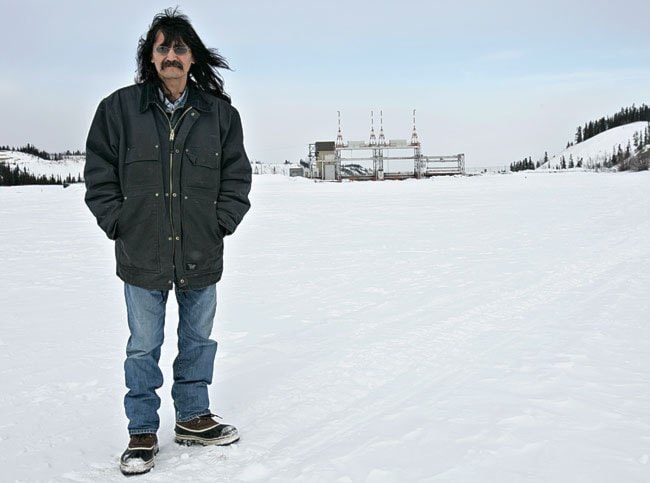When the Aishihik dam was built in the early 1970s, the river went into cardiac arrest, says Gerald Dickson.
“The river’s like a heart—if you block its arteries, it has a heart attack.”
The dam hurt the fish, ducks, muskrats, beaver and the people that live there, said the First Nation filmmaker.
“So I made a film to show the impact it’s had on the Champagne/Aishihik First Nation.”
Called Declining Food Source, the film reveals that “the government breached its fiduciary responsibility” when it made an agreement with Champagne/Aishihik to put in the dam, said Dickson.
Back in the 1970s, NCPC, precursor to Yukon Energy, made an agreement with former chief Albert Isaac, he said.
“He was 90-years-old, and couldn’t speak English.”
At the time, the company was told the First Nation was getting organized and was in the process of establishing a new chief, said Dickson.
“But they went ahead anyway, and made the deal with old Isaac.”
After the dam was built, water levels in Aishihik Lake began to fluctuate dramatically.
It dropped 2.7 metres, said Dickson.
“And those low levels effect the areas where ducks and geese eat—their habitat,” he said.
Dickson recalls motoring around an island while out in a boat during the making of the film.
The next day, when he went back, the island was high and dry.
“You could walk around it,” he said.
“And I saw fish stranded in puddles.”
The elders say the fish are dying, added Dickson.
The best fishing used to be at the north end of Aishihik near the old village.
“But now you can walk right across the bay where the water used to be,” he said. “So the dam has impacted the livelihood of Champagne/Aishihik’s food source.”
Fish are in trouble below the dam too, he said.
There used to be a lot of rainbow trout below Otter Falls, said Dickson.
“But that habitat was destroyed.”
Dams also block all the nutrients that usually flow in the water, and it stagnates, he said.
Dickson talked to a First Nation member whose trapline was undermined by the dam.
“It wiped out 90 per cent of his game,” he said.
The old Indian village of Chemi, on the Aishihik River, was also flooded, added Dickson.
Now, the water is back down, but the houses are sinking, and there’s bank erosion.
“So Champagne/Aishihik has to undergo a mitigation project to preserved it,” said Dickson.
And Yukon Energy is still talking about adding another turbine at Aishihik, he said.
Dickson has always been interested in “how water impacts us,” he said.
A Kluane First Nation member, he sat at the table during final agreement negotiations.
“And I negotiated for us to own beds of water,” he said.
Unbeknownst to them, most First Nations have given up these rights, he added.
Kluane’s final agreement divided the settlement land into approximately 40 parcels, said Dickson.
The First Nation was given water rights in only one of those 40 parcels.
“I wanted rights to the beds of water in all the parcels,” said Dickson.
“But the government wouldn’t allow it.”
Dickson argued for water rights in one of the First Nation’s main salmon-bearing creeks.
“But they wouldn’t give us that either,” he said.
“I’m worried about giving away our water.”
The Kluane First Nation has a lot of glaciers.
And all that water is vulnerable, said Dickson.
“Down the road big companies are going to come in and try and take that water.”
It’s already happening all over the world, he said.
Water is being privatized in parts of Europe, the US and South America.
In fact, in Bolivia, after private companies bought the countries water supply, it was even illegal to collect rainwater.
However, after civil unrest, riots and civilian deaths, the country changed its laws.
“Our water is subject to free trade on the global market,” said Dickson.
And the community needs to create a coalition to protect it, he said.
“We’ve got the second-biggest ice field in North America.
“And that ice could be sold, if it comes down to it.”
When the Aishihik dam was put in, the First Nation members received several thousand dollars in settlement money, said Dickson.
“One elder said, ‘Sure we were compensated, but that money’s all gone and the dam is still here.’”
Declining Food Supply is showing at the Yukon College lecture hall on Sunday, March 22 at 6 p.m.
Admission is by donation.
The award-winning documentary Blue Gold: World Water Wars is also being screened.
Contact Genesee Keevil at gkeevil@yukon-news.com
